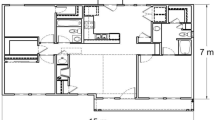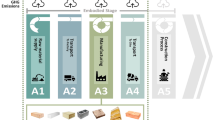Abstract
Purpose
Most life cycle assessment (LCA) studies for flooring exclude the environmental and economic impacts incurred from the maintenance required due to uncertainty in average cleaning procedures, although some studies indicate that it may be the most significant component of the life cycle. This study investigates the impacts of maintenance on types of flooring and develops a single scoring system to compare floors based on both environmental and economic impacts.
Methods
The focus of this study was on the impact of maintenance on the life cycle of flooring choices. Maintenance data was collected from trade association studies and manufacturer’s recommendations. This data was compiled, along with data from previous flooring studies, to create a comprehensive life cycle inventory which was analyzed with the LCA software, SimaPro. A number of maintenance techniques and frequencies were tested in order to do a sensitivity analysis. An uncertainty analysis was completed using Monte Carlo simulations. A life cycle costing (LCC) analysis was used to evaluate the total present value cost of flooring including maintenance. Environmental and economic impacts were normalized to create a single score in order to compare the overall performance of flooring choices.
Results and discussion
Maintenance procedures may account for a significant portion of environmental and economic impacts of floorings. In the case of environmental scores, adding high maintenance to the life cycle can increase scores by anywhere from 31 % (hardwood) to 114 % (carpet). A sensitivity analysis of these scores shows that most of the score increase can be attributed to vacuuming. Maintenance costs considerably increase the total cost, accounting for 49 % of hardwood’s total cost and about 30 % of costs for linoleum, vinyl, and carpet. The expected service life of the home greatly influences which flooring is best, as costs and environmental scores change dynamically over time. For the expected service life of a home of 61 years, carpet has the worst and linoleum has the best overall performance.
Conclusions
Although averages for maintenance techniques are not currently known, ignoring maintenance as a part of the use phase presents a significant error in the comparison of flooring options environmentally and economically. Due in part to yearly maintenance effects, the flooring choice with the best overall performance changes dynamically depending on the expected service life remaining for the home.





Similar content being viewed by others
References
Aktas CB, Bilec MM (2012) Impact of lifetime on US residential building LCA results. Int J Life Cycle Assess 17(3):337–349
Armstrong (2012) Maintenance recommendations & procedures for commercial resilient, hardwood & laminate flooring. Armstrong Commercial Flooring, USA
Baitz M, Kreißig J, Byrne E, Makishi C, Kupfer T, Frees N, Bey N, Hansen MS, Hansen A, Bosch T, Borghi V, Watson J, Miranda M (2004) Life cycle assessment of PVC and of principal competing materials. European Commission, Leinfelden-Echterdingen
Carpet and Rug Institute (2014a) About CRI. http://www.carpet-rug.org/about-cri/what-is-cri/. Accessed 20 Feb 2014
Carpet and Rug Institute (2014b) Residential vacuuming. http://www.carpet-rug.org/residential-customers/cleaning-and-maintenance/basic-cleaning/vacuuming.cfm. Accessed 25 Feb 2014
Carpet and Rug Institute (2014c) Residential deep cleaning and selecting a carpet cleaning professional. http://www.carpet-rug.org/residential-customers/cleaning-and-maintenance/deep-cleaning-and-selecting-a-carpet-cleaning-professional.cfm. Accessed 28 Feb 2014
Cetiner I, Edis E (2014) An environmental and economic sustainability assessment method for the retrofitting of residential buildings. Energy Build 74:132–140
ChemDry (2014) http://www.chemdry.com/residential. Accessed 12 Dec 2013
D&R International (2012) 2011 Buildings energy data book. US Department of Energy: Energy Efficiency & Renewable Energy, pp 1–6
Energy Information Administration (2011) Emissions of greenhouse gases in the United States 2009. US Department of Energy, p 22
Energy Information Administration (2014) Electric power monthly: average retail price of electricity to ultimate customers by end-use sector. http://www.eia.gov/electricity/monthly/epm_table_grapher.cfm?t=epmt_5_6_a. Accessed 23 Jan 2014
Environmental Protection Agency (2002) Solid waste management and greenhouse gases: a life-cycle assessment of emissions and sinks
Environmental Protection Agency (2009) Water on tap: what you need to know
Forbo (2008) Cleaning & maintenance of marmoleum floors. http://www.forbo-flooring.com/Residential-flooring/Installation-floorcare/Floorcare/. Accessed 28 Feb 2014
Franke DL, Cole EC, Leese KE, Foarde KK, Berry MA (1997) Cleaning for improved indoor air quality: an initial assessment of effectiveness. Indoor Air 7(1):41–54
Frischknecht R, Jungbluth N, Althaus H-J, Doka G, Dones R, Heck T, Hellweg S, Hischier R, Nemecek T, Rebitzer G, Spielmann M (2005) The ecoinvent database: overview and methodological framework. Int J Life Cycle Assess 10(1):3–9
Fuller S, Peterson S (1996) Life-cycle costing manual for the federal energy management program. NIST Handbook 135. Gaithersburg, Maryland, USA
Goedkoop M, Heijungs R, Huibregts M, Schryver AD, Stuijs J, van Zelm R (2012) ReCiPe 2008: a life cycle impact assessment method which comprises harmonised category indicators at the midpoint and the endpoint level
Günther A, Langowski H-C (1997) Life cycle assessment study on resilient floor coverings. Int J Life Cycle Assess 2(2):73–80
Heijungs R, Settanni E, Guinée J (2013) Toward a computational structure for life cycle sustainability analysis: unifying LCA and LCC. Int J Life Cycle Assess 18(9):1722–1733
Hofstetter P (1998) Perspectives in life cycle impact assessment: a structured approach to combine models of the technosphere, ecosphere and valuesphere. Kluwer Academic, Zurich
Homewyse (2014) Home service costs. www.homewyse.com. Accessed 12 Dec 2013
Hoogmartens R, Van Passel S, Van Acker K, Dubois M (2014) Bridging the gap between LCA, LCC and CBA as sustainability assessment tools. Environ Impact Assess 48:27–33
Hunkeler D, Lichtenvort K, Rebitzer G, Ciroth A (2008) Environmental life cycle costing. Hunkeler D, Lichtenvort K, Rebitzer G (eds); lead authors, Ciroth A et al. Pensacola, Florida, SETAC; Boca Raton, CRC
Jönsson Å (1999) Including the use phase in LCA of floor coverings. Int J Life Cycle Assess 4(6):321–328
Jönsson A, Tillman A-M, Svensson T (1997) Life cycle assessment of flooring materials: case study. Build Environ 32(3):245–255
Jørgensen A, Herrmann I, Bjørn A (2013) Analysis of the link between a definition of sustainability and the life cycle methodologies. Int J Life Cycle Assess 18(8):1440–1449
Kloepffer W (2008) Life cycle sustainability assessment of products. Int J Life Cycle Assess 13(2):89–94 (with Comments by Helias A. Udo de Haes, p. 95)
Kloepffer W, Ciroth A (2011) Is LCC relevant in a sustainability assessment? Int J Life Cycle Assess 16(2):99–101
Lippiatt B, Greig AL, Lavappa P (2010) Building for Environmental and Economic Sustainability (BEES). National Institute of Standards and Technology, Gaithersburg
Lowes (2014) Clean hardwood floors. http://www.lowes.com/cd_how+to+clean+hardwood+floors_1314379252_. Accessed 28 Feb 2014
Matos GR (2009) Use of minerals and materials in the United States from 1900 through 2006. US Geological Survey
National Center for Healthy Housing (2008) Carpets and healthy homes. http://www.nchh.org/Portals/0/Contents/CarpetsHealthyHomes.pdf. Accessed 12 Dec 2013
National Wood Flooring Association (2014) Frequently asked questions: care & maintenance. http://woodfloors.org/care-maitenance.aspx. Accessed 28 Feb 2014
Nebel B, Zimmer B, Wegener G (2006) Life cycle assessment of wood floor coverings—a representative study for the German flooring industry. Int J Life Cycle Assess 11(3):172–182
Nelson AC (2004) Toward a new metropolis: the opportunity to rebuild america. The Brookings Institution Metropolitan Policy Program
Office of Management and Budget (2013) Circular A-94 appendix C. White House (December 2013)
Paulsen J (2001) Life cycle assessment for building products: the significance of the usage phase. Dissertation, Kungliga Tekniska Högskolan, Stockholm
Paulsen J (2003) The maintenance of linoleum and PVC floor coverings in Sweden the significance of the usage phase in an LCA. Int J Life Cycle Assess 8(6):357–364
Potting J, Blok K (1995) Life-cycle assessment of four types of floor covering. J Clean Prod 3(4):201–213
Rushing AS, Kneifel JD, Lippiatt BC (2013) Energy price indices and discount factors for life-cycle cost analysis 2013. Annual supplement to NIST handbook 135 and NBS special publication 709, vol NISTIR 85-3273-28. National Institute of Standards and Technology, Gaithersburg
Sanz C (2012) Working with linoleum flooring. This Old House
Soratana K, Marriott J (2010) Increasing innovation in home energy efficiency: Monte Carlo simulation of potential improvements. Energy Build 42(6):828–833
Swarr TE, Hunkeler D, Klöpffer W, Pesonen HL, Ciroth A, Brent AC, Pagan R (2011) Environmental life-cycle costing: a code of practice. Int J Life Cycle Assess 16(5):389–391
US Census Bureau (2007) Ceramic wall and floor tile manufacturing (NAICS 327122). http://thedataweb.rm.census.gov/TheDataWeb_HotReport2/econsnapshot/snapshot.hrml?NAICS=327122&IND= %3DCOMP %28 %28C4*C4 %29 %2FC4 %29&STATE=ALL&COUNTY=ALL. Accessed 20 Feb 2014
Woller J (1996) The basics of Monte Carlo simulations. http://www.chem.unl.edu/zeng/joy/mclab/mcintro.html. Accessed 18 Feb 2014
Acknowledgments
This research was supported by the Brook Byers Institute for Sustainable Systems, Hightower Chair, and the Georgia Research Alliance at the Georgia Institute of Technology. The views and ideas expressed herein are solely of the authors and do not represent the ideas of the funding agencies in any form.
Author information
Authors and Affiliations
Corresponding author
Additional information
Responsible editor: Hanna-Leena Pesonen
Rights and permissions
About this article
Cite this article
Minne, E., Crittenden, J.C. Impact of maintenance on life cycle impact and cost assessment for residential flooring options. Int J Life Cycle Assess 20, 36–45 (2015). https://doi.org/10.1007/s11367-014-0809-z
Received:
Accepted:
Published:
Issue Date:
DOI: https://doi.org/10.1007/s11367-014-0809-z




